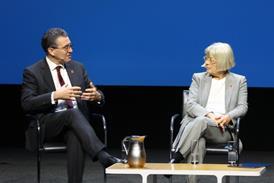Last month, Law Society president Paul Marsh opened a debate entitled ‘Legal aid: a vision for the next 60 years’. The panel included the legal aid minister, Lord Bach. There was plenty of talk about the parlous state of legal aid. Vision, however, was in short supply.
At the meeting, Andrew Caplen, chair of the access to justice committee, announced a Law Society review of access to justice. This is timely because we are at a critical moment. Legal aid needs a vision for the next 60 years, even if it has managed pretty well until recently without one. Lord Hailsham used to boast that it was the ‘fastest growing social service’. That was almost certainly not what Mrs Thatcher intended – it was the result of a lack of concern over the growth of a relatively low budget for a broadly desirable service. But, to survive the next 60 years, legal aid not only needs a clearer vision, it needs a sharper voice in which it can successfully articulate its case for funding against its competitors.
If visions are distant, nightmares are close. Legal aid expenditure has been held at around £2bn for the last few years. There is no legal impediment to it being slashed further. Play the defence of legal aid wrong and we could very well find expenditure reducing. In particular, the civil budget of £800m could be devastated at the stroke of a pen. Services in crime and public law will be protected because of the fair trial guarantee of Article 6 of the European Convention on Human Rights (the effect of which will remain whatever happens to the Human Rights Act). However, compulsory competitive tendering could be deployed to bring down criminal costs to rock-bottom levels. Provision would be reduced to a bureaucratised rump of privatised public defenders with pre-determined market shares.
So how might the access to justice committee come up with an alternative, and less depressing, vision of the future? To do so, we have to forget professional advantage, even for beleaguered groups of practitioners. We need to stress the socially inclusive nature of access to justice and the constitutional importance of fair trial. We have to accept that legal aid will, henceforth, be a declining (yet not inconsiderable) source of professional income. For both the bar and solicitors, appeal to relatively low incomes against the rest of the legal profession will get us nowhere. The more telling comparisons will be with teachers, social workers and doctors.
As a matter of practical politics, we must surely accept that the overall legal aid budget is capped. Our job will be to hold that cap at £2bn plus inflation and the cost of additional services. The failure to accept this is a weakness of the otherwise interesting contribution to this debate recently published by the Legal Action Group – The Justice Gap: Whatever Happened to Legal Aid? by Steve Hynes and Jon Robins. The old argument about justice being without price may be eternally valid – it is just that no-one will hear it anymore.
The core of the problem is crime. The overall cost has to be brought down to preserve civil. Lord Mackay once remarked that we were about at the end of what could be done ‘without radical change’. He was right. The only game in town appears to be the hopes riding on competitive tendering – a policy first advocated by Lord Mackay himself. But competitive tendering will cut competition for clients; diminish quality; require more management than is planned; and bureaucratise provision. The more radical option, which allows for a bit more vision, is to do what has actually been very successfully done before – radically restructure court procedures and substantive law (in the late 1970s, it was divorce) to save legal aid. For example, could expensive serious fraud trials be replaced by cheaper offences based on breaches of clearer statutory duties? Could the cost be shifted to stronger City regulators? What changes are needed to ensure that no jury trial lasts beyond three months? Standard or graduated fees might well be a better way of regulating the budget and respecting the dignity of clients than hawking consolidated bundles of cases to the lowest bidder.
On the civil side, three things must happen. First, the Community Legal Service (CLS) desperately needs a coherent vision. It ought to limit itself to being a comprehensive advice and information provider, providing assistance in social welfare law. We should argue to bring the not-for-profit movement and, in particular, the powerful citizens advice movement firmly into the CLS fold. There needs to be a binding together of provisions that includes national telephone and web services, not-for-profit advice, assistance and lawyers where their expertise is needed. Second, there has to be a clear policy about what should happen to family law and what help is provided, on what terms and why.
Third, let us examine the case for reintegrating the funding of money claims into legal aid through the replacement of conditional fee agreements and remaining areas of legal aid into a publicly run contingency legal aid fund (CLAF). Might a CLAF allow a better regulated and broader system of litigation than conditional fee agreements that implicitly prioritise certain types of ‘slam dunk’ cases?
Practitioners, readers and Law Society members may not agree with all – or any – of the above. The important thing is the quality of the debate of the society’s access to justice review. Paradoxically, if we are to defend the profession’s manifest material interest in legal aid then we have to do so in terms rigidly aligned with the interest of lawyers’ clients. Otherwise, the next 60 years is all downhill.
Roger Smith is director of the law reform and human rights organisation Justice

















![Eleanor Clarke - 029[8]](https://d1d8vslyhr7rdg.cloudfront.net/Pictures/274x183/1/5/1/120151_eleanorclarke0298_527574_crop.jpg)







No comments yet